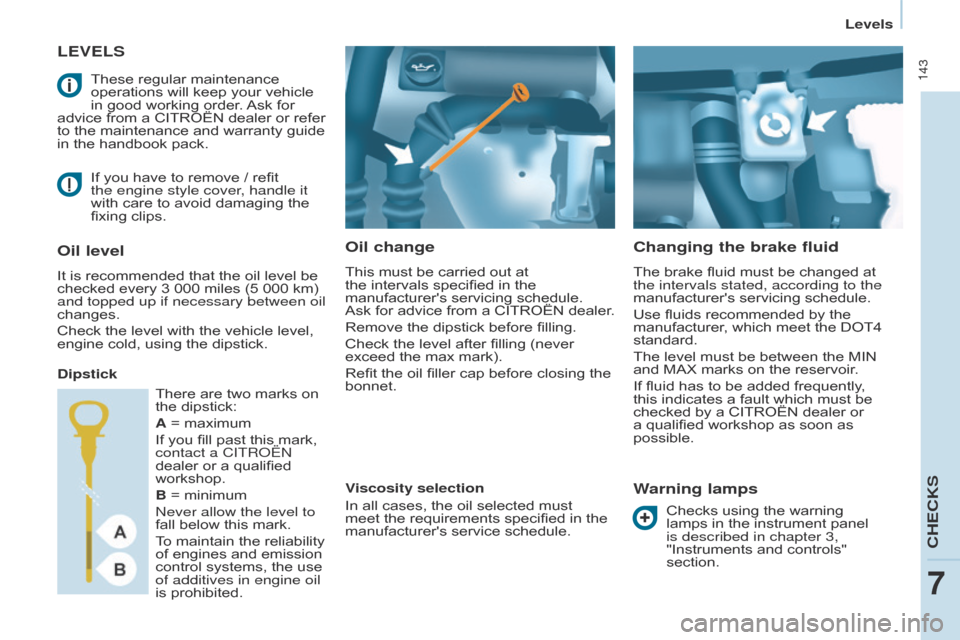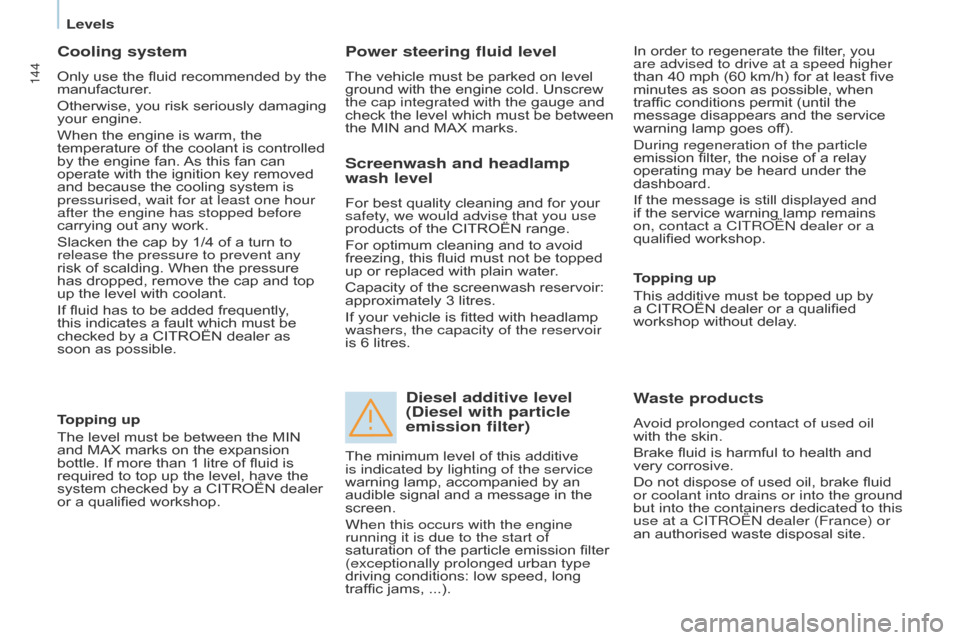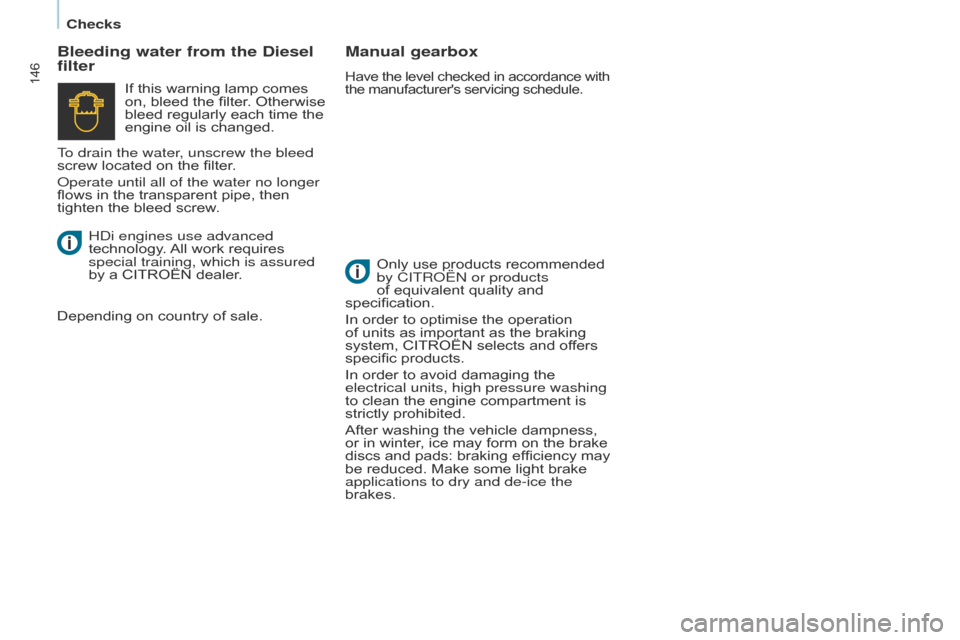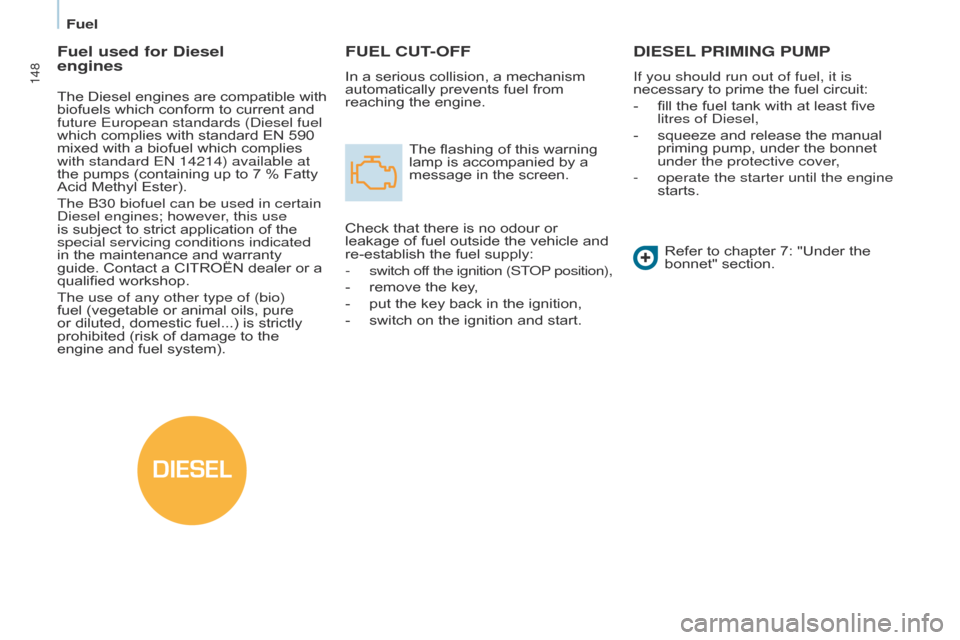warning Citroen BERLINGO MULTISPACE RHD 2015 2.G Service Manual
[x] Cancel search | Manufacturer: CITROEN, Model Year: 2015, Model line: BERLINGO MULTISPACE RHD, Model: Citroen BERLINGO MULTISPACE RHD 2015 2.GPages: 276, PDF Size: 12.21 MB
Page 140 of 276

Berlingo_2_VP_en_Chap06_Accessoire_ed02-2014
138
The fitting of electrical equipment or accessories which are not
recommended by CITROËN may
result in a failure of your vehicle's
electronic
system. Please note this
specific
warning.
Y
ou are advised
to contact a dealer to be shown the
range
of recommended equipment or
accessories.
d
epending on the country in which
the
vehicle is sold, it is compulsory
to have a high visibility vest, warning
triangle and spare bulbs available in
the
vehicle. "Active Fleet
d ata" telematic unit
Connected directly to the heart of the
vehicle
(multiplexed network: "Full
CAN"),
the telematic unit, by means of
a
"ready to use" service, permits the
sending
in real time of information
such
as:
-
distance travelled,
-
distance
remaining before the next
service,
-
warnings and faults (oil level,
coolant
level, oil temperature,
coolant
temperature, etc...).
This
enables "Fleet" managers
to
optimise the monitoring and
management
of their professional
vehicles.
d
epending on country, contact a
CITROËN dealer
for more information.
Equipment
Page 145 of 276

Berlingo_2_VP_en_Chap07_Verification_ed02-2014
143
LEVELSOil change
This must be carried out at the intervals specified in the
manufacturer's
servicing schedule.
Ask
for
advice
from
a
CITROËN
dealer
.
Remove
the dipstick before filling.
Check
the level after filling (never
exceed
the max mark).
Refit
the oil filler cap before closing the
bonnet.
changing the brake fluid
The brake fluid must be changed at the intervals stated, according to the
manufacturer's servicing schedule.
Use
fluids recommended by the
manufacturer
, which meet the DOT4
standard.
The
level must be between the MIN
and
MAX marks on the reservoir.
If
fluid has to be added frequently,
this
indicates a fault which must be
checked
by a CITROËN dealer or
a
qualified workshop as soon as
possible.
Warning lamps
If you have to remove / refit
the engine style cover , handle it
with
care to avoid damaging the
fixing
clips.
Oil level
It is recommended that the oil level be checked every 3 000 miles (5 000 km)
and topped up if necessary between oil
changes.
Check
the level with the vehicle level,
engine
cold, using the dipstick.
d
ipstick
Viscosity selection
In
all cases, the oil selected must
meet
the requirements specified in the
manufacturer's
service schedule.
These
regular maintenance
operations
will keep your vehicle
in
good working order.
Ask
for
advice
from a CITROËN dealer or refer
to
the maintenance and warranty guide
in
the handbook pack.
Checks using the warning
lamps
in the instrument panel
is described in chapter 3,
"Instruments
and controls"
section.
There
are two marks on
the
dipstick:
A
= maximum
If
you fill past this mark,
contact a CITR
o Ë n
dealer
or a qualified
workshop.
B
= minimum
n
ever allow the level to
fall
below this mark.
To
maintain the reliability
of
engines and emission
control
systems, the use
of additives in engine oil
is
prohibited.
Levels
CHECkS
7
Page 146 of 276

Berlingo_2_VP_en_Chap07_Verification_ed02-2014
144
cooling system
Only use the fluid recommended by the manufacturer.
Otherwise,
you risk seriously damaging
your
engine.
When
the engine is warm, the
temperature
of the coolant is controlled
by
the engine fan.
As
this fan can
operate
with the ignition key removed
and
because the cooling system is
pressurised, wait for at least one hour
after the engine has stopped before
carrying
out any work.
Slacken
the cap by 1/4 of a turn to
release the pressure to prevent any
risk
of scalding. When the pressure
has
dropped, remove the cap and top
up
the level with coolant.
If
fluid has to be added frequently,
this
indicates a fault which must be
checked
by a CITROËN dealer as
soon
as possible.
Power steering fluid level
The vehicle must be parked on level ground with the engine cold. Unscrew
the cap integrated with the gauge and
check
the level which must be between
the
MIN and MAX marks. In
order to regenerate the filter, you are advised to drive at a speed higher
than
40 mph (60 km/h) for at least five minutes
as soon as possible, when
traffic
conditions permit (until the
message
disappears and the service
warning
lamp goes off).
d
uring regeneration of the particle
emission
filter, the noise of a relay
operating
may be heard under the
dashboard.
If
the message is still displayed and
if
the service warning lamp remains
on, contact a CITR
o Ë n dealer or a
qualified
workshop.
topping up
The
level
must
be
between
the
MIN
and
MAX
marks
on
the
expansion
bottle.
If
more
than
1
litre
of
fluid
is
required
to
top
up
the
level,
have
the
system
checked
by
a
CITROËN
dealer
or
a
qualified
workshop.
Screenwash and headlamp
wash level
For best quality cleaning and for your safety , we would advise that you use
products
of the CITROËN range.
For
optimum cleaning and to avoid
freezing,
this fluid must not be topped
up
or replaced with plain water.
Capacity
of the screenwash reservoir:
approximately
3 litres.
If
your vehicle is fitted with headlamp
washers, the capacity of the reservoir
is
6 litres.
diesel additive level
( d iesel with particle
emission filter)
topping up
This additive must be topped up by
a
CITROËN dealer or a qualified
workshop
without delay.
Waste products
avoid prolonged contact of used oil
with the skin.
Brake
fluid is harmful to health and
very
corrosive.
Do
not dispose of used oil, brake fluid
or coolant into drains or into the ground
but into the containers dedicated to this
use at a CITR
o Ë n dealer (France) or
an
authorised waste disposal site.
The
minimum
level
of
this
additive
is indicated by lighting of the service
warning
lamp,
accompanied
by
an
audible
signal
and
a
message
in
the
screen.
When this occurs with the engine
running it is due to the start of
saturation
of
the
particle
emission
filter
(exceptionally prolonged urban type
driving
conditions:
low
speed,
long
traffic
jams,
...).
Levels
Page 148 of 276

Berlingo_2_VP_en_Chap07_Verification_ed02-2014
146
Bleeding water from the diesel
filter Manual gearbox
Have the level checked in accordance with the
manufacturer's servicing schedule.
Only use products recommended by CITRo Ë n or products
of
equivalent quality and
specification.
In
order to optimise the operation
of
units as important as the braking
system,
CITROËN selects and offers
specific
products.
In
order to avoid damaging the
electrical units, high pressure washing
to
clean the engine compartment is
strictly
prohibited.
After
washing the vehicle dampness,
or
in
winter, ice may form on the brake
discs
and pads: braking efficiency may
be
reduced. Make some light brake
applications to dry and de-ice the
brakes.
If
this
warning
lamp
comes
on,
bleed
the
filter.
Otherwise
bleed
regularly
each
time
the
engine
oil
is
changed.
H
d
i engines use advanced
technology.
All
work
requires
special training, which is assured
by
a
CITROËN
dealer.
Depending
on
country
of
sale.
To drain the water, unscrew the bleed
screw
located
on
the
filter.
o
perate until all of the water no longer
flows
in
the
transparent
pipe,
then
tighten
the
bleed
screw.
checks
Page 149 of 276

Berlingo_2_VP_en_Chap07_Verification_ed02-2014
147
FILLInG WItH FuEL
Low fuel level
Filling
The fuel tank must be filled with the
engine off.
-
Open
the fuel filler flap.
-
Insert
the key, then turn it a quarter
turn.
-
Remove
the cap and hook it onto
the clip located on the inside of the
flap.
When
filling with fuel, a
mechanical
system prevents
opening
of the left-hand side door.
When
the fuel filler flap is open, ensure
that
no one tries to slide this door.
Once
the flap has been closed, the
sliding
side door may jam, push the
door
to close it then open it.
When
the
minimum
fuel
tank
level is reached, this warning
lamp
comes
on.
You then have
approximately 8 litres of
fuel
remaining.
Fill
up
without
delay
to
avoid
running
out
of
fuel.
Never
risk
driving
until
you
run
out
of
fuel
as
this
may
damage
the
emissions
control
and
injection
systems. A
label affixed to the inside of the flap
reminds
you of the type of fuel to be
used.
Y
ou must fill with at least 5 litres of fuel
for
it to be registered by the fuel gauge.
When
the fuel filler cap is opened,
there
may be a slight air suction noise.
This
vacuum is entirely normal and is
due
to the sealing of the fuel circuit.
When
filling the fuel tank, do not
continue after the 3rd cut-off of the
nozzle.
This
could
cause malfunctions.
The
capacity
of
the
fuel tank is
approximately
60
litres.
-
After
filling
the
fuel tank, lock the
cap
and
close
the flap.
Fuel used for petrol engines
The petrol engines are compatible with E10 bio-petrol (containing 10 %
ethanol), conforming to European
standards
EN 228 and EN 15376.
E85 type fuels (containing up to 85 %
ethanol) are reserved exclusively for
vehicles
marketed for the use of this
type
of fuel (BioFlex vehicles).
The
quality
of the ethanol must comply with
European
standard EN 15293.
Fuel
cHEcKS
7
Page 150 of 276

DIESEL
Berlingo_2_VP_en_Chap07_Verification_ed02-2014
148
FuEL cut-OFF
In a serious collision, a mechanism automatically prevents fuel from
reaching
the engine.
The
flashing of this warning
lamp
is accompanied by a
message
in the screen.
Check
that there is no odour or
leakage
of fuel outside the vehicle and
re-establish
the fuel supply:
-
switch of
f the ignition (ST
o
P position),
-
remove
the key,
-
put
the key back in the ignition,
-
switch
on the ignition and start.
dIESEL PrIMInG PuMP
If you should run out of fuel, it is
necessary to prime the fuel circuit:
-
fill
the fuel tank with at least five
litres of
d iesel,
-
squeeze
and release the manual
priming
pump, under the bonnet
under the protective cover
,
-
operate the starter until the engine
starts. Refer
to chapter 7: "Under the
bonnet"
section.
Fuel used for diesel
engines
The Diesel engines are compatible with biofuels
which conform to current and
future European standards (
d iesel fuel
which
complies with standard EN 590
mixed
with a biofuel which complies
with standard E
n 14214) available at
the
pumps (containing up to 7 % Fatty
Acid
Methyl Ester).
The B30 biofuel can be used in certain
d
iesel engines; however, this use
is
subject to strict application of the
special servicing conditions indicated
in
the maintenance and warranty
guide.
Contact a CITROËN dealer or a
qualified
workshop.
The use of any other type of (bio)
fuel
(vegetable or animal oils, pure
or
diluted, domestic fuel...) is strictly
prohibited
(risk of damage to the
engine
and fuel system).
Fuel
Page 151 of 276

Berlingo_2_VP_en_Chap07_Verification_ed02-2014
149
AdBLuE® AddItIVE
A
nd S
cr
SYS t EM
FO
r B
L
u
E H dI dIESEL
E
n
GI
n
ES
To assure respect for the environment and conformity with the new Euro 6
emissions
standard, without adversely
af
fecting the performance or fuel
consumption
of Diesel engines,
CITROËN
has taken the decision to
equip
its vehicles with an effective
system
that associates SCR (Selective
Catalytic Reduction) with a particle
filter
(FAP) for the treatment of exhaust
gases.
Presentation of the Scr system
Using an additive called adBlue®
containing urea, a catalytic converter
turns up to 85% of nitrous oxides
(
no
x) into nitrogen and water, which
are
harmless
to
health
and
the
environment.
The
a
dBlue
® additive is held in a
special
tank
located under the boot
at
the
rear
of the vehicle. It has a
capacity
of
17 litres: this provides a
driving
range of about 12 500 miles
(20
000 km), after which an alert
is triggered warning you when the
reserve
remaining is enough for just
1
500
miles
(2 400 km).
d
uring each scheduled service of
your vehicle by a CITR
o Ë n dealer
or
a
qualified workshop, the
AdBlue®
additive
tank
is
refilled
in
order
to
allow
normal
operation
of
the
SCR
system.
If
the
estimated
mileage
between
two services is greater than
12 500 miles
(20
000
km),
we
recommend
that
you
go
to
a
CITROËN
dealer
or
a
qualified
workshop
to
have
the
necessary
top-up
carried
out.
o
nce the a dBlue
® tank is empty, a
system
required by regulations
prevents
starting
of the engine.
If the SCR
is faulty, the level of
emissions
from
your
vehicle will no
longer
meet
the
Euro
6 standard: you
vehicle
becomes
polluting.
In
the
event
of
a
confirmed fault
with
the
SCR
system,
you must go
to
a
CITROËN
dealer
or a qualified
workshop
as
soon
as
possible: after
a
running
distance
of
650 miles
(1
100
km),
a
system
will be triggered
automatically
to
prevent engine
starting.
AdBlue® additive
cHEcKS
7
Page 152 of 276

Berlingo_2_VP_en_Chap07_Verification_ed02-2014
150
range indicators
When switching on the ignition, an
indicator gives an estimate of the
distance that can be travelled with
your vehicle before engine starting
is
automatically prevented, once the
vehicle starts using the reserve of a
dBlue
® or after a fault is detected with
the
SCR system.
In
the
event of simultaneous system
fault and low a
dBlue
® level, the
shortest
range
is
the
one displayed.
In the event of the risk
of non-starting related to a lack
of AdBlue
®
The engine start prevention
system required by regulations is
activated
automatically once the
a
dBlue
® tank is empty.
range greater than 1 500 miles (2 400 km)
When the ignition is switched on, no
information on range is displayed
automatically
in the instrument panel.
Pressing this button
displays the driving range
temporarily.
Above
3 000 miles
(5
000 km), the value is
not
specified. When switching on the ignition, the
UREA warning
lamp comes on,
accompanied
by an audible signal and
the
display of a message (e.g.: "Top up
emissions
additive: Starting prevented
in
900 miles") indicating the remaining
range
expressed in miles or kilometres.
When
driving, the message is
displayed
every 150 miles (300 km)
until
the additive tank has been
topped-up.
Go
to a CITROËN dealer or a qualified
workshop
to have the
AdBlue® tank topped-up.
Y
ou
can
also
top-up
the
tank
yourself.
Refer
to
the
"Topping-up"
section.
r
emaining range between 350 and
1500 miles (600 and 2 400 km)
adBlue® additive
Page 153 of 276

Berlingo_2_VP_en_Chap07_Verification_ed02-2014
151
When switching on the ignition, the
SERVICE warning lamp comes on
and
the UREA
warning lamp flashes,
accompanied
by an audible signal and
the
display of a message (e.g. "Top up
emissions
additive: Starting prevented
in
350 miles") indicating the remaining
range
expressed in miles or kilometres.
When
driving, the message is
displayed every 30 seconds until the
additive
tank has been topped-up.
Go
to a CITROËN dealer or a qualified
workshop
to have the
AdBlue® tank topped-up.
Y
ou
can
also
top-up
the
tank
yourself.
Refer
to
the
"Topping-up"
section.
o
therwise you will not be able to
restart
your
engine. When switching on the ignition, the
SERVICE
warning lamp comes on
and
the UREA
warning lamp flashes,
accompanied
by an audible signal
and
the display of the message
"T
op up emissions additive: Starting
prevented".
The
a dBlue
® tank is empty: the system required
by
regulations prevents
engine
starting. To be able to start the engine,
we
recommend that you call on
a
CITROËN dealer or a qualified
workshop
for the top-up required. If
you carry out the top-up yourself, it is
essential
to add at least 3.8 litres of
a dBlue
® to the tank.
r
emaining range between 0 and
350 miles (0 and 600 km) Breakdown related to a lack of
AdBlue
® additive
Refer to the "Topping-up" section.
adBlue® additive
CHECkS
7
Page 154 of 276

Berlingo_2_VP_en_Chap07_Verification_ed02-2014
152
In the event of a fault with
the the Scr emissions control
system
When switching on the ignition, the
URE
a , SERVICE and diagnostic
warning
lamps comes on, accompanied
by an audible signal and the display of
a
message "Emissions fault" to signal a
fault
with the emissions control system.
If
it is a temporary fault, the alert
disappears once the exhaust gas
emissions
return to normal.during an authorised driving phase (between
650 miles and 0 miles) (1 100 km and 0 km)
A system that prevents engine starting
is activated automatically
from
650 miles (1 100 km) after
confirmation
of a fault with the SCR
emissions
control system. Have the
system
checked by a CITROËN dealer
or
a
qualified workshop as soon as
possible. In the event of the detection
of a fault
If a fault with the SCR system is
confirmed
(after 30 miles (50 km)
covered
with the permanent display of
the
message signalling a fault), when
switching on the ignition, the SER
VICE
and
engine diagnostic warning lamps
come
on and the UREA
warning lamp
flashes,
accompanied by an audible
signal
and the display of a message
(e.g.:
"Emissions fault: Starting
prevented
in 150 miles") indicating the
remaining
range express in miles or
kilometres.
While
driving, the message is
displayed every 30 seconds while the
fault
with the SCR system persists.
You should go to a CITR
o Ë n dealer
or
a qualified workshop as soon as
possible.
o
therwise, you will not be able to
restart
your engine.
adBlue® additive